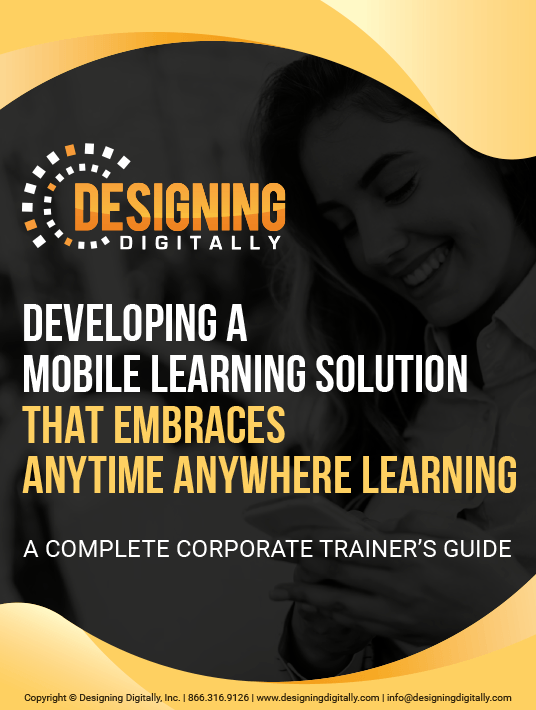What Is Anytime Anywhere Learning?
Anytime Anywhere Learning is the concept of delivering training to learners at the moment they want it using the technology they prefer. The most common delivery system for this training model is mobile learning, which can be offered on desktops, laptops, tablets, and smartphones. In this article, I review the abundant benefits of this training strategy.

It Supports Learner Initiative
When a learner has sought out information, they are showing an interest in learning and are much more likely to stay engaged with the material. Combine the ability for learners to access the training they need via the method, location, and time of their choosing, and you have ensured that your learners have all of the tools they need to enthusiastically master their on-the-job duties. In a recent study of over 1,000 U.S. workers, 87% agreed that it was “important to have access to training information anytime and anywhere they need it in order to do their jobs.” Each of your employees has a time of day, location, device and in which they prefer to learn. Some of your employees are morning people who are energized by rising early and jumping right into the day, while others thrive later in the evening as those early risers sleep. Some prefer to sit at a desk and view the training on large desktop monitors, while others prefer using their smartphones during their subway commute. There is no universal right or wrong solution here— and instead, it’s important to give each individual the tools they need to capitalize on training within the time and place that is most effective and convenient for them.
It Allows For Flexibility Of Ever-Changing Culture
No single solution fits every need of every learner within each group. By providing a training framework that is scalable and independent of time and space, you’ve provided a malleable solution that will work for employees for many years to come. Mobile learning has the flexibility to cater to any learner’s situation and preference. Although internet coverage continues to spread globally, there are plenty of places that wifi is not readily available, or the internet remains completely inaccessible, particularly in rural areas. To combat this, courses may be downloaded for offline access, giving employees the added flexibility to take advantage of offline times and places.
It Gives Your Employees The Support They Need When They Need It
When learners are trained in a typical classroom setting but receive no reinforcement or follow-up to that training, they are likely to forget 80% of the information they have learned within 30 days. There is nothing worse than feeling ill-prepared before heading into an important meeting or completing a task that has high costs associated with mistakes. Anytime Anywhere Learning delivers the information your employees need right at the time they need it.
It Allows Learners To Use The Device They Prefer
Anytime Anywhere Learning capitalizes on employees’ preferences, giving them the ability to access training on the device of their choice. Studies show that 80% of people use smartphones, and within this group, they look at their phone over 200 times a day. It’s safe to infer that smartphones create a captive audience. If the training device of your employees’ choice is their smartphone, you may be concerned that they could become distracted by games or social media. This concern is founded in truth— your learners use them to play games and browse social media, but that does not mean they aren’t an effective training tool. If you provide on-the-job time for learners to complete mobile learning, help curb off-topic use by setting clear parameters for your employees regarding what activity is not permitted during that time.
Develop A Plan For Success
Now that you know the importance of mobile learning, the next steps involve developing a sound plan as you begin to design for mobile learning. Dive into the specifics, such as who your learners are, where they are, what devices they use, and what they need to learn. This will help you to create a needs analysis, a deep dive into a study of your audience in relation to your training needs that will steer your decision-making process as you proceed through your training’s creation. The environment that your learners will be in is an important consideration. For example, consider whether your learners are in situations that allow them to listen to an audio as they complete training. According to Google Insights, people use an average of 2.5 devices to connect to the internet daily. The majority of these devices are smartphones. Explore your audience to find out if this is true for your group as well, and be sure to take note of any common devices amongst them. If the majority of your learners are using a specific device, it makes sense to design the course in a way that is optimized for that exact device.
When deciding on course structure, the content should be broken down into topic-based modules that will help the learner to immediately access the information that they need. The best way to break topics down is to think of the duties your employees will be subsequently performing after completing the training and design each module with these tasks in mind. Testing should be a vital step in your plan. Gather a small group of end users and ask for their advice regarding the direction you plan to take at each critical step, keeping your plan flexible enough to accommodate for this critical feedback. With a Learning Management System (LMS) in place, you can track which of your employees have completed your mobile training with the added bonus additional data about your employees’ training performance. An LMS provides a dashboard of metrics that give you a clear picture of each of your employees’ comprehension about each topic in your training. You know how long it took the learner to complete simulation or the accuracy in which they completed quizzes. This gives you a valuable opportunity to provide additional training to those who may be struggling to master a concept or procedure, as well as identify employees that excel for career advancement.
Anytime Anywhere Learning provides access to vital information that addresses different learning styles and preferences. With this training approach, your employees are more confident in their job roles and will feel appreciated knowing they have opportunities to support and improve their skills. To ensure the most effective implementation, work with experts who are able to guide you in the right direction and can design training that produces the results and return on investment you hoped for.
Download the eBook, Developing A Mobile Learning Solution That Embraces Anytime Anywhere Learning, to learn of the many benefits of a mobile learning solution and review some of the key factors of this training approach.







